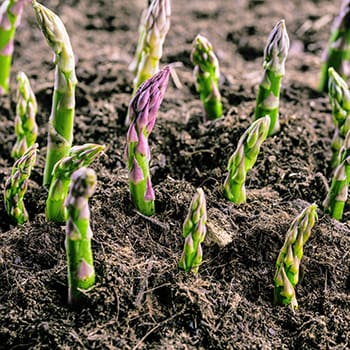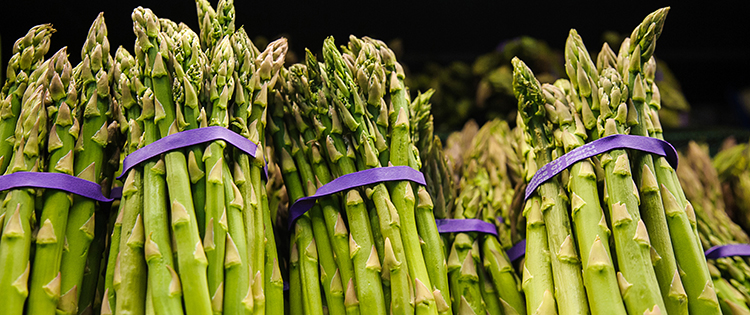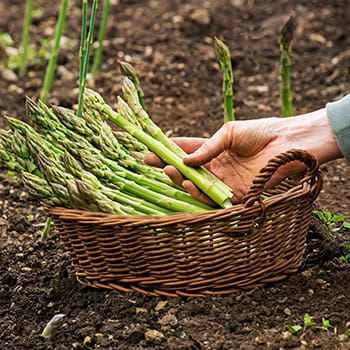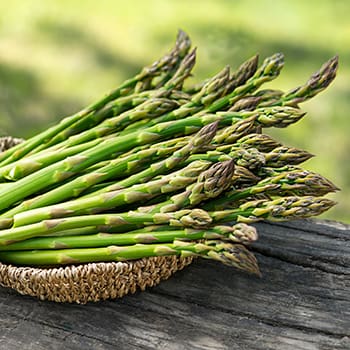One of a few plants is a perennial so aggressive that you’ll never believe that you haven’t already had a garden plot overrun with this wonderful vegetable. What are we talking about today? Asparagus waits for no one, including all of us. This hardy vegetable is ready to take over the world and it starts here. Let’s get to it!
Seeds or Crowns?
I’m going to go with some simple facts to start off with: you can grow asparagus from seed. You can, but it is highly recommended that you start from 1–3-year-old crowns that have already produced stalks and are relatively well established in their current planter.
If you do decide that you want to start with “your” plant (ie: you want to grow from seed), you’re going to need a few years of patience before you’re harvesting those tender green stems and enjoying your freshly grown asparagus. We’ll talk about that more in a second.
I recommend growing from established crowns because they’ve already been through the hardest part: establishing the plant. Young asparagus plants, even the hardiest varieties, can be difficult to work with. They tend to get root bound very quickly and will often require a quick step up between pot sizes with very little notice. If you’re a very experienced gardener, go for it. If you’re just starting out, sincerely, work from crowns that others have already pulled through the hard years. You’ll thank yourself for it later on.
The First Few Years
If you’re working with less than 2-year-old crowns, feel free to peruse this section. If you have 3-year-old or older crowns, skip ahead.
The first few years for any asparagus plant are the hardest that the plant will face. The parameters of the soil don’t have to be absolutely perfect (this isn’t an orchid, after all), but you’ll see long-term effects (such as weak harvests early on or in elder years) if they aren’t as close to perfect as possible.
For the first two seasons of an asparagus crown, you’ll see little stems pop up out of the soil but the last thing you want to do is take them from their plant. If the plant seems to be overburdened, feel free to trim the smallest stems back. But otherwise, let the asparagus plant do its thing. It needs this growth to, essentially, feed itself and grow into a properly mature plant.
When your asparagus crown turns 3, it’s time to go ahead and take a light harvest from your plant. There’s a simple trick our forefathers used to make the most of their harvest, without actually planting much. It’s a method you can use today, on any kind of crop, and you’ll probably get enough food to last you for a month straight.
The Ideal Harvest
At 3 years old, your plant is ready to start offering your table something delicious: fresh asparagus that has a light, delicate flavor. There will be very little “woodiness” in these spears even if you allow them to mature to a long height simply because that crown isn’t old enough to produce that heavy stalk yet.
The first few years that you harvest your asparagus, leave a few stems to let the plant continue to feed itself from that green waste and establish the root system.
Never trim back any ferns that grow from your asparagus plant. These are important to allow the plant to feed itself.
Pots vs Beds
I am a huge fan of allowing asparagus to take root in very large pots, usually 1-2 plants per pot. Why? This allows me to move them wherever and whenever I need to. Simply put them on moving casters or allow the pots to have locking wheels and there you go. It also makes it easier to continue to prevent root rot from overwatering if you have some extremely rain, as we tend to get in this area.
That said, asparagus simply wants to have a permanent home more than anything else. If you plant it somewhere, make sure it’s going to be staying there for at least 10 years. If you intend to change what you’re planting on a regular basis and where you plant it, asparagus may not be the best choice for you.
I like to say that asparagus is one of the few plants that is extremely introverted: its a homebody that would much rather just hang out on the couch than go out and party. Berries are more likely to be happy about moving than a few crowns of asparagus would be.
This, again, is why I prefer to pot my asparagus. They’re rarely disturbed and they can be wheeled anywhere they need to without having to distress the established crown.
Why Asparagus Grows So Long
When treated properly and gently (neutral to slightly acidic soil (6.5 PH at most), light watering that drains well, and full sun that doesn’t roast the plant), asparagus may be one of those plants that you find yourself passing on to your kids or grandkids. There are well-known asparagus varieties and individual plants that have happily produced for upwards of thirty years or more. That’s a very long time for any garden plant!
Bluntly, if you’re going to be good to your asparagus, they will never leave you; unless an animal digs them up and eats them. Asparagus is generally very hardy, as mentioned before, and incredibly long-lived.
Should you decide to grow asparagus after reading this article and you want to put it in the ground, my suggestion is to think of it like a fruit tree. You wouldn’t consider pulling up a peach, pear, or apple tree after only five or six years; asparagus requires the same consideration and gentle measures.
Talk to us about your asparagus adventures! Do you have a favorite variety? A favorite place to plant it or a preferred planting pal? Have you sworn off asparagus because you simply have a freezer full of it and you don’t know what else to do with all those beautiful spears? Or do you love your beautiful asparagus plants and want to convert everyone else reading this?
Toss us a comment down below and, as always, Happy Gardening!
An Insanely Effective Way to Build a 5 Year Food Stockpile (Video)












I put in an asparagus patch this past April. I purchased crowns that were very healthy looking and I think they are 2 yrs. old. The plants are doing very well and I plan to mulch with rotted manure in the coming days as we are starting to get really cool fall weather now. The ferns are still very green at the moment. My question is, what do you do with the asparagus plants that have berries? When I bought my crowns I was told most of the plants would be male (they produce more spears than female plants). But I see some with alot of berries and I’m just wondering should I remove them or leave them be?
Hello Christine. Asparagus is my domain in the garden. The author of this article might be by for a response but I’ll tell you what I do. I leave the berries alone. Let the berries mature and turn red. Next spring, you might notice the young shoots of a tiny asparagus plant sprouting. I use those tiny plants to either extend my rows or fill in an open space in one of my rows. You’ll have to let those small plants be for a few years until they get established and then you should be fine. If you are asking if you should dig up the entire plant with berries and replace it, I would not. It’s established and contributing to the yearly asparagus harvest. Good luck!
Thanks for the advice Ron, greatly appreciated. I have started asparagus from seed (heirloom variety) as well and plan to put those little plants into the garden this fall. Many thanks again.
I planted 6 cute plants last year by my fence. I did not know it would be SO hot there. It has cooled off and my plants have grown and are so fuzzy and neat looking. I live in the Northern NV desert of Carson City. Now I want to put mine in pots on wheels to roll inside when it is too cold or to shade when hot. Now I am afraid to transplant them. What should I do? Will freezing kill them?
Hi Nan, I think they should take the freeze fine. I live in New Hampshire where winters can get to 25 below zero and worse. Asparagus does fine up here. But of course that’s planting them in the ground. We had a very hot summer here (very hot for NH) and drought conditions too and they did fine. Maybe you should consider planting them in the ground and shading them with if temps exceed 100? You can make a simple structure with some lathe. The gentleman above who answered my question may be able to suggest something (Ron).
I planted about 4 rows of 2/3 yr old roots in a 4×10 raised bed about 6 years ago. I hoped they would spread but they haven’t. I’ve only gotten a few stalks each year. Not sure what I’ve done wrong.
What should be done with potted asparagus through New Hampshire winters? Or should they only be planted in the ground?